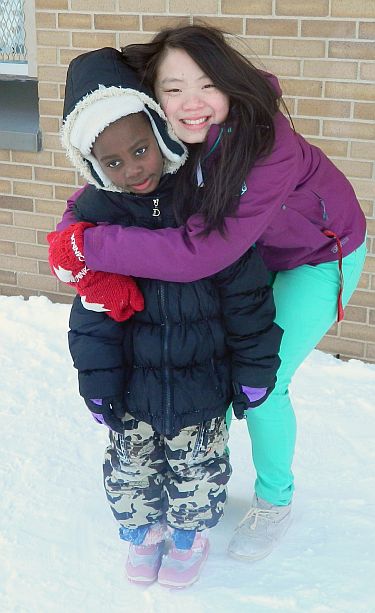
Anti-Bullying
Harvest City Christian Academy (HCCA), in conjunction with the HCCA Parent Teacher Association (PTA) has adopted the following anti-bullying policy.
Purpose: HCCA seeks to provide a safe, nurturing, learning environment in a Christian context. Therefore, we, as staff, endeavour to teach and model Christ-like behavior. We believe that, before God, we are not to be satisfied with outer conformity to a policy, but through prayer and speaking the truth in love, we are to seek for an inner transformation of the heart. That having been attained, the individual will begin to respond out of a desire to please God and not just conform to a rule or policy. In other words, our ultimate goal is to change the heart to change the behavior. That is for life and to the glory of God!
To this end, we are to encourage and correct in a spirit of love and humility, not just bullying behaviors, but such things as selfishness, unkindness, and inconsideration. We believe this to be an outgrowth of our values as an intentionally Christian community. Our proof texts are the two greatest commandments: we are “to love God with our whole being” and “to love our neighbour as ourself”.
Harvest City Christian Academy, therefore, seeks to provide a learning environment free from harassment and bullying of any kind. We, the community and supporters of HCCA, are committed to providing a compassionate, receptive, and non-threatening atmosphere in which each and every one of our pupils can learn and flourish. We promote an attitude of respect and dignity towards others. We prohibit all forms of bullying.
What is Bullying?
Webster dictionary: “To intimidate or oppress someone weaker than oneself” Bullying is identified as any behavior, verbal or non-verbal that is intended to cause physical, emotional, psychological or social harm. Bullying may be direct (face to face) or indirect. Bullying behaviors that are not addressed generally escalate into more aggressive behaviors over time. Bullying carries the ramification of causing pain and stress to the victim. Bullying is never justified and is not excusable as “kids being kids,” “just teasing”, or any other rationalization. In other words, it is characterized by “the intent” of an individual or individuals to do harm to another individual or individuals.
For our purposes, it includes but is not limited to behaviors that take place in the school, on school field trips, or on school property during school hours. It also includes any school events that may take place outside of regular school hours on or off of school property. Bullying Behaviors The following is a list of behaviors that demonstrate bullying. A student who demonstrates a bullying behavior may not be a bully. It is the goal of HCCA to reduce bullying by addressing these types of behaviors as they occur.
Specific types of bullying may include, but are not limited to:
Physical Behavior: Intentionally endangering the welfare of others. Examples include, but are not limited to: Hitting, shoving, kicking, spitting on, punching, pushing, blocking, tripping, throwing things at a person, unwanted touching, rude gestures, taking or damaging another’s property, extortion of money or other items, making someone do something they otherwise would not do etc.
Verbal behavior: Name-calling, ridiculing, using words to attack, threaten or insult. Examples may include but are not limited to: Spreading rumors, making fun of a student’s appearance, mannerisms, intelligence, physical characteristics, cultural background or actions. Name calling, teasing, bossing, threatening, put downs etc. It may also include taunts, slurs etc. that attack a person’s race or ethnicity.
Indirect behavior: Indirect bullying includes but is not limited to the following: Exclusion from activities or social groups, circulating inappropriate notes or pictures in any medium (paper, cell phone, internet…), using or encouraging others to bully. It may also include racist behavior such as spreading graffiti, notes etc. with racial slurs.
Cyber-bullying: In as much as technological advances have provided opportunities for students to communicate electronically, the following behaviors will be considered bullying behaviors: Sending of inappropriate or threatening emails or text messages, creating or posting inappropriate or threatening information or pictures on websites (i.e. Facebook, Instagram, Snap Chat etc).
Sexual: Initiating and/or executing unwanted physical contact, making sexually threatening and/or abusive comments. Examples may include but are not limited to: Grabbing a victim’s body, using derogatory labels such as “slut” etc.
Psychological/Emotional: Acts that instill a sense of fear or anxiety, etc. Examples may include, but are not limited to: Any act that insults or demeans an individual in such a way as to cause distress, reluctance to attend school, a decline in work standards or problem behaviors. Shunning, excluding or tormenting, causing someone to be “left-out” of a game or activity, blaming, making threatening faces or gestures etc.
Reporting Bullying It is the responsibility of all persons to report any and all occurrences of bullying behaviors as outlined in this policy either directly or indirectly (ie., through a parent or guardian) to the staff. They should be able to do so without fear of negative reflection or consequences. However, any person who withholds information regarding bullying behavior or provides inaccurate or false information because of malicious intent will be subject to disciplinary action.
Proper Bullying Reporting/Response Procedures:
- All bullying incidents should be reported immediately to a staff member.
- Staff members will record all reported incidents that meet the bullying criteria and all such reports will be signed by the principal.
- The incident will be investigated immediately.
- If it is established that bullying has occurred, the principal or designated staff person will meet with the perpetrator to administer appropriate correction [ie., depending on the ages of the students involved, the circumstances or the severity of the incident, and the respective response(s) of the perpetrator(s).]

